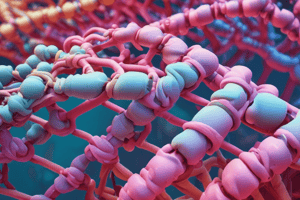Podcast
Questions and Answers
Which structure represents the secondary structure of a protein?
Which structure represents the secondary structure of a protein?
- β-pleated sheet
- Tertiary structure
- Primary structure
- α-helix (correct)
What is an important tool for predicting protein structure and function?
What is an important tool for predicting protein structure and function?
Determining sequence homology
Protein function is directly related to the protein's tertiary structure.
Protein function is directly related to the protein's tertiary structure.
True (A)
The tertiary structure of a protein is less conserved than the primary structure.
The tertiary structure of a protein is less conserved than the primary structure.
What holds the β-pleated sheet together?
What holds the β-pleated sheet together?
Where are the side chains located in an α-helix?
Where are the side chains located in an α-helix?
What amino acid residue's backbone forms a hydrogen bond with the backbone of the sixth residue?
What amino acid residue's backbone forms a hydrogen bond with the backbone of the sixth residue?
Which peptide segment is most likely to be part of a stable α-helix at physiological pH?
Which peptide segment is most likely to be part of a stable α-helix at physiological pH?
How many residues are in a segment of a single chain in an antiparallel β sheet that has a length of 305 Å?
How many residues are in a segment of a single chain in an antiparallel β sheet that has a length of 305 Å?
Match the following descriptions to the correct structure (α Helices, β Sheets, β Turns, or All):
Match the following descriptions to the correct structure (α Helices, β Sheets, β Turns, or All):
What is the length of a 35.0 kDa single-stranded α-helical protein segment?
What is the length of a 35.0 kDa single-stranded α-helical protein segment?
What characterizes an amphipathic α helix?
What characterizes an amphipathic α helix?
Which two synthetic polypeptides can form an α-helix at the indicated pH values?
Which two synthetic polypeptides can form an α-helix at the indicated pH values?
Flashcards are hidden until you start studying
Study Notes
Protein Structures
- The secondary structure of a protein includes configurations like the α-helix and β-pleated sheet.
- An α-helix exhibits side chains on its exterior, while β-pleated sheets are stabilized by hydrogen bonds between adjacent segments.
Tertiary and Evolutionary Relationships
- Sequence homology is crucial for predicting protein structure and function.
- Tertiary structures are more conserved evolutionarily than primary structures.
α-Helices
- The α-helix structure involves hydrogen bonding between the first and fifth residues (H-bonding occurs between residue n and n+4).
- Length of a 35.0 kDa single-stranded α-helix segment is approximately 477 Å, based on 318 residues, with each residue contributing 1.5 Å.
β-Sheets
- In β-sheets, successive R groups alternate directions, allowing for unique structural integrity.
- An antiparallel β-sheet segment measuring 305 Å comprises approximately 87 residues, calculated using the 3.5 Å distance between residues.
β-Turns
- β-turns involve hydrogen bonding between the first and fourth residues (H-bonding occurs between residue n and n+3).
Classification of Structures
- All protein structural types (α-helices, β-sheets, β-turns) feature –NH groups that form hydrogen bonds with C=O groups.
- Amphipathic α-helices have one side of predominantly hydrophobic residues and another of hydrophilic residues, while amphipathic β-sheets alternate between polar and nonpolar residues.
Synthetic Polypeptides
- Polylysine can form an α-helix at pH 13, while polyglutamate does so at pH 2, illustrating the impact of chemical environment on protein structure.
Studying That Suits You
Use AI to generate personalized quizzes and flashcards to suit your learning preferences.




